In a world where the home office has become more than just an afterthought, creating a space that inspires productivity and creativity is no longer a luxury—it’s a necessity. Whether you’re just venturing into the realm of home decor or you’re a seasoned stylist looking to refresh your workspace, this article will guide you through 13 innovative designs that promise to transform your home office into a sanctuary of inspiration.
For those new to the art of interior design, fear not; we’re here to make the process both exciting and approachable. Seasoned decorators, prepare to be inspired by fresh ideas that challenge the conventional and invite new perspectives into your creative process. Each design we’ll explore is a testament to the transformative power of thoughtful decor, offering practical insights that cater to both function and style.
Expect to discover a variety of styles and solutions that cater to different needs, from maximizing small spaces to incorporating the latest trends in color and texture. By the end of this journey, you’ll be equipped with the knowledge and confidence to create a home office that not only reflects your personal style but also enhances your productivity and well-being. Get ready to be inspired, as we delve into the world of home offices that are as functional as they are fabulous.
Optimizing Small Office Spaces
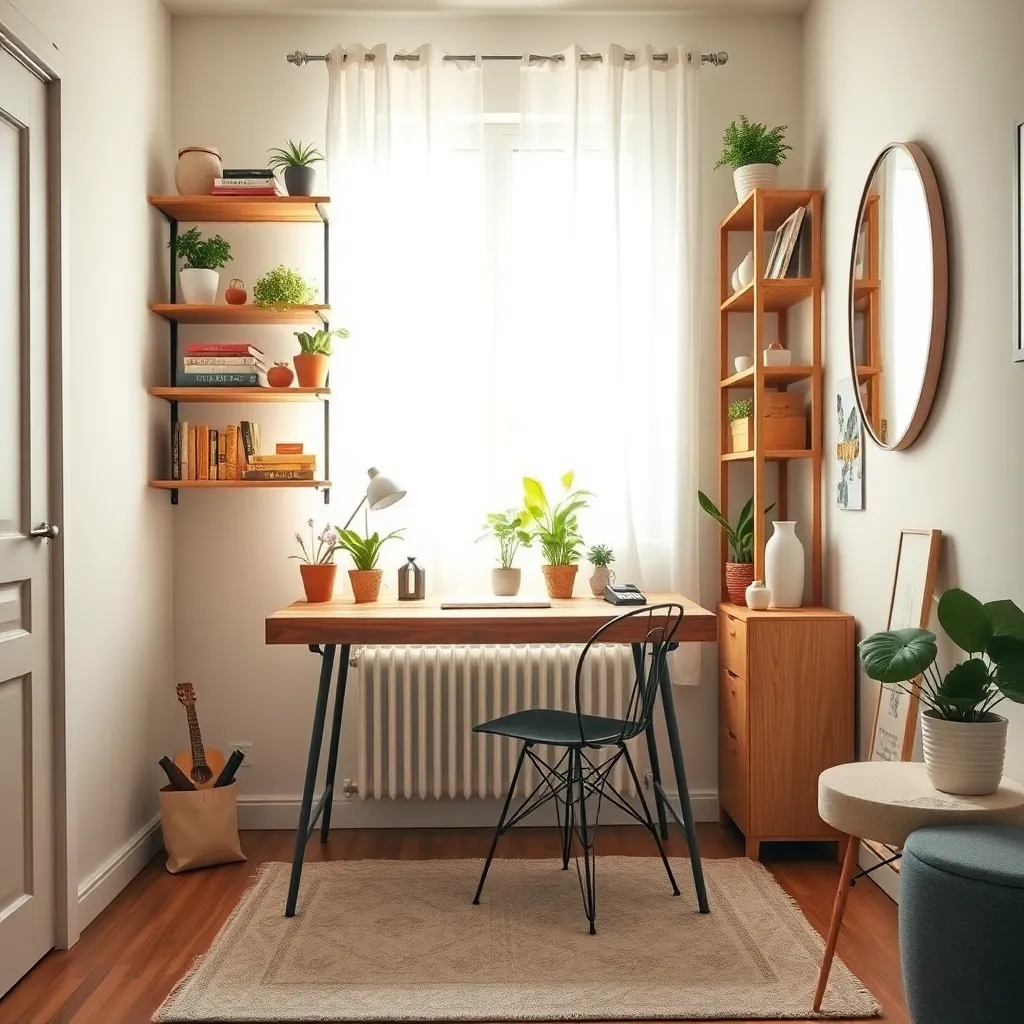
To make the most of small office spaces, consider choosing furniture that serves multiple purposes. Compact desks with built-in storage can maximize functionality without crowding the room.
Lighting plays a crucial role in enhancing a small office’s ambiance and functionality. Opt for wall-mounted lights or pendant lighting instead of floor lamps to save precious floor space.
Color schemes can significantly affect how spacious your office feels. Use light, neutral tones on walls and larger furniture to create an open and airy atmosphere, while incorporating splashes of color through accessories.
For those looking to add a personal touch, consider using a feature wall with removable wallpaper. This allows you to experiment with bold patterns or colors without overwhelming the entire space, and it can easily be changed when you desire a refresh.
Incorporating Natural Light Sources
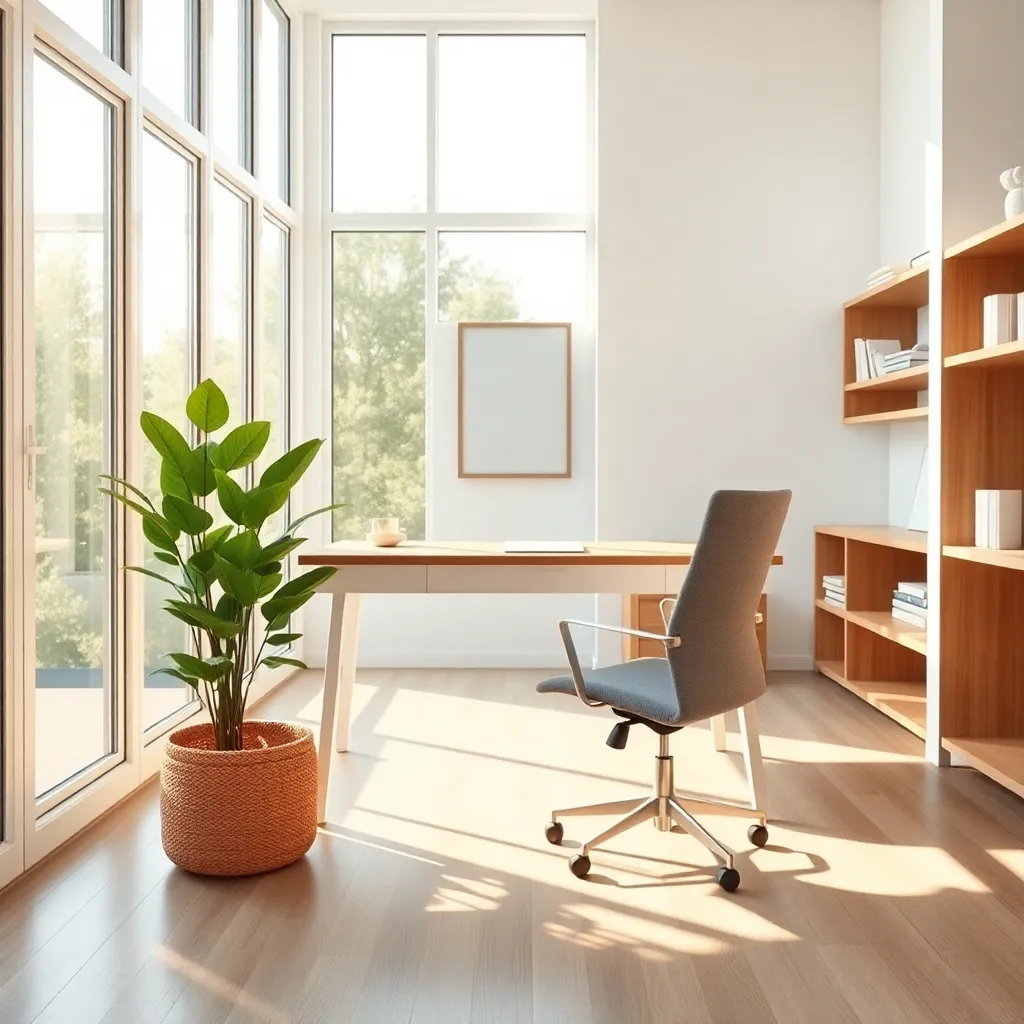
Incorporating natural light into your home office can transform the space, making it feel more open and inviting. Start by positioning your desk near a window to take advantage of the sunlight, which can enhance productivity and improve your mood.
Consider using light-filtering curtains or blinds that allow in soft, diffused light while reducing glare on your computer screen. For a seamless look, choose materials like linen or cotton in neutral tones, which can complement any decor style.
Mirrors are another effective tool for maximizing natural light. Placing a large mirror opposite the window can reflect sunlight throughout the room, creating an illusion of a larger, brighter space.
For those interested in a more advanced approach, installing a skylight could be a fantastic option. Skylights provide additional overhead light, which can brighten up areas that windows cannot reach, and work particularly well in home offices with sloped ceilings.
Choosing Ergonomic Furniture Options
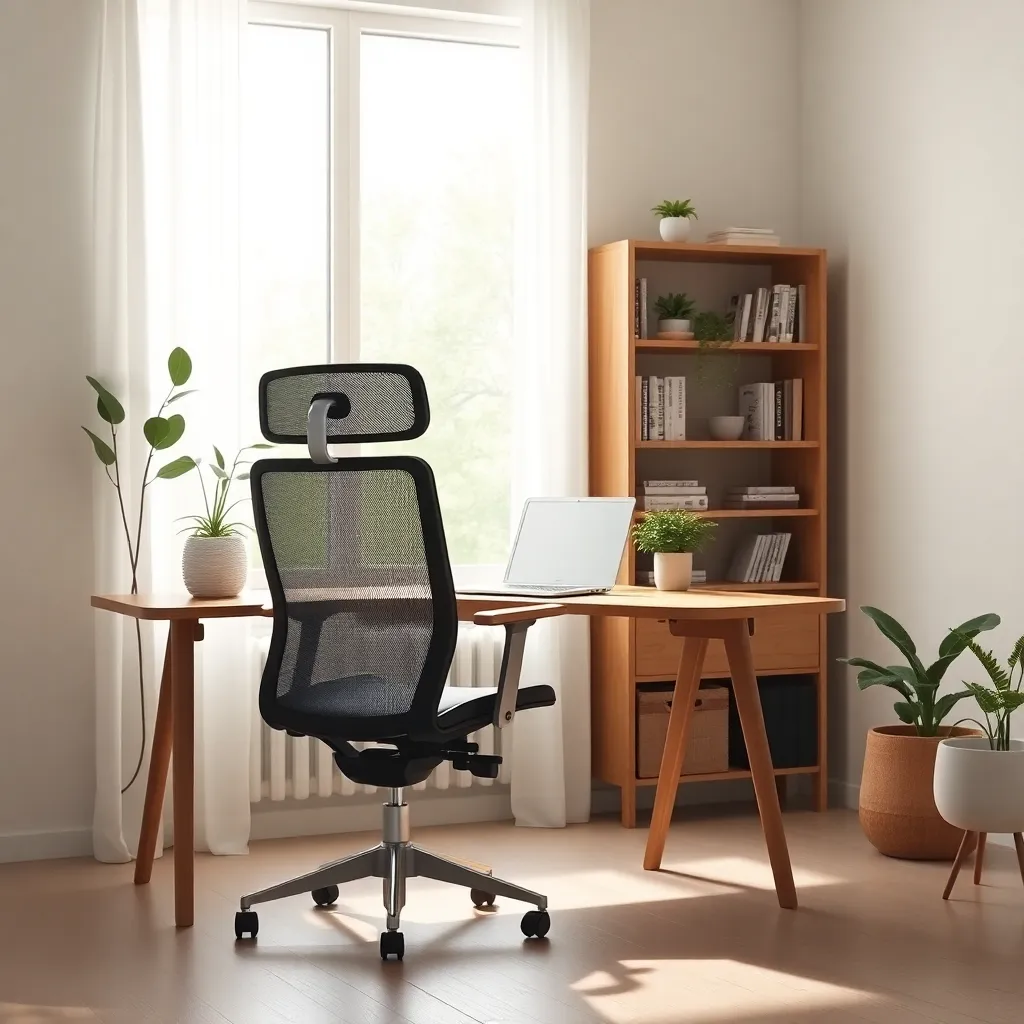
To create a home office that’s both stylish and comfortable, start by selecting ergonomic furniture that supports your body during long work hours. Opt for an adjustable chair that offers lumbar support, and pair it with a desk at the correct height to ensure your screen is at eye level, reducing strain on your neck and shoulders.
Consider materials like mesh or high-quality fabric for breathability, which can enhance comfort during extended use. Color plays a key role too; choose neutral tones like grey or beige for larger furniture pieces, and add pops of color with accessories to maintain a lively yet professional atmosphere.
It’s important to also consider the layout of your furniture to maximize space and functionality. Position your desk near a window if possible, to combine the benefits of natural light with the ergonomic setup, helping to reduce eye strain and boost productivity.
For more advanced decorators, integrating smart furniture technology can further enhance the ergonomics of your home office. Height-adjustable desks that allow you to switch between sitting and standing positions can improve circulation and reduce fatigue, making them a worthwhile investment for your workspace.
Integrating Multifunctional Storage Solutions
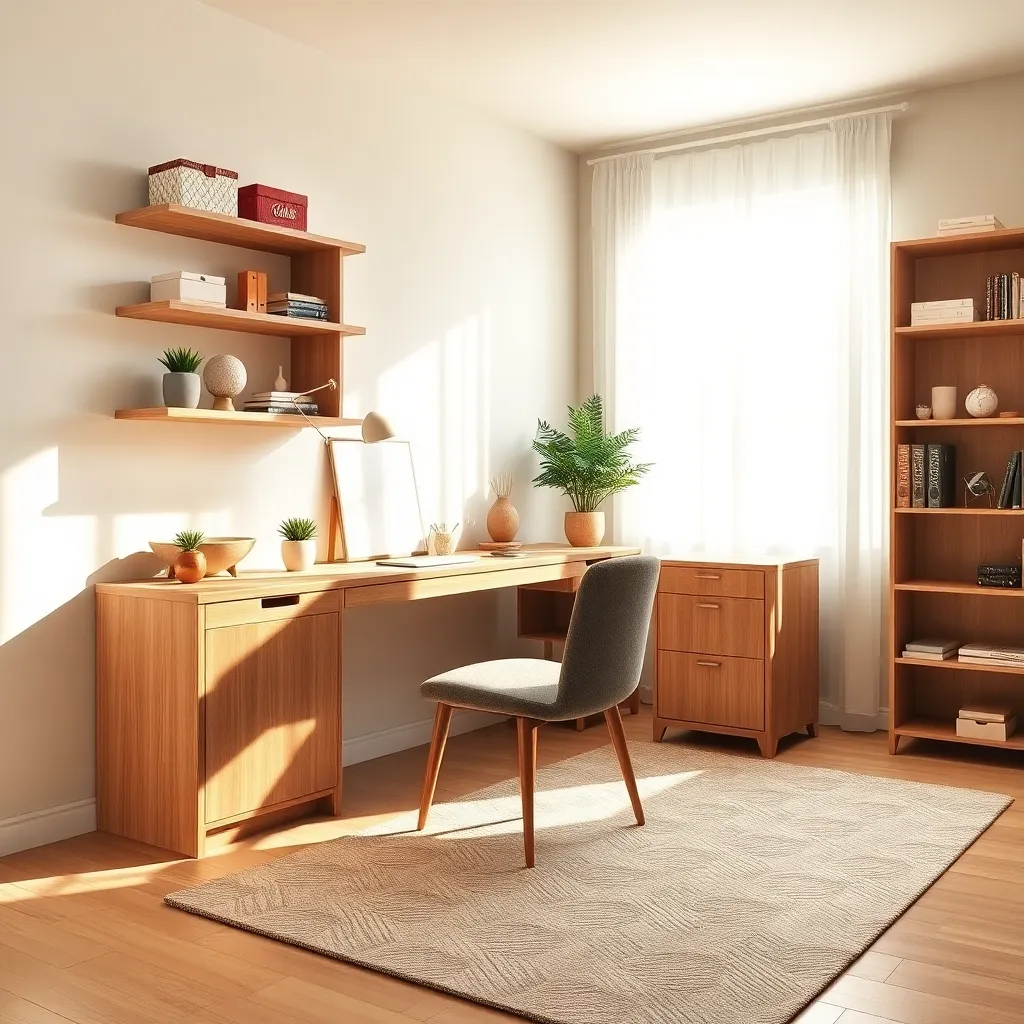
Maximizing storage in a home office can boost both functionality and aesthetics. Consider installing wall-mounted shelves or floating desks to free up floor space while keeping essential items within reach.
Opt for furniture pieces that serve multiple purposes to optimize your workspace. A desk with built-in drawers or a convertible bookshelf can provide ample storage without sacrificing style.
Color can play a significant role in the perception of space. Choose light, neutral tones for your storage units to create an open, airy feel, and add pops of color with accessories for a personalized touch.
To add a touch of sophistication, consider materials like glass or metal for your storage solutions. These materials not only add a modern flair but are also durable and easy to maintain, ensuring your office remains sleek and functional.
Utilizing Bold Color Schemes
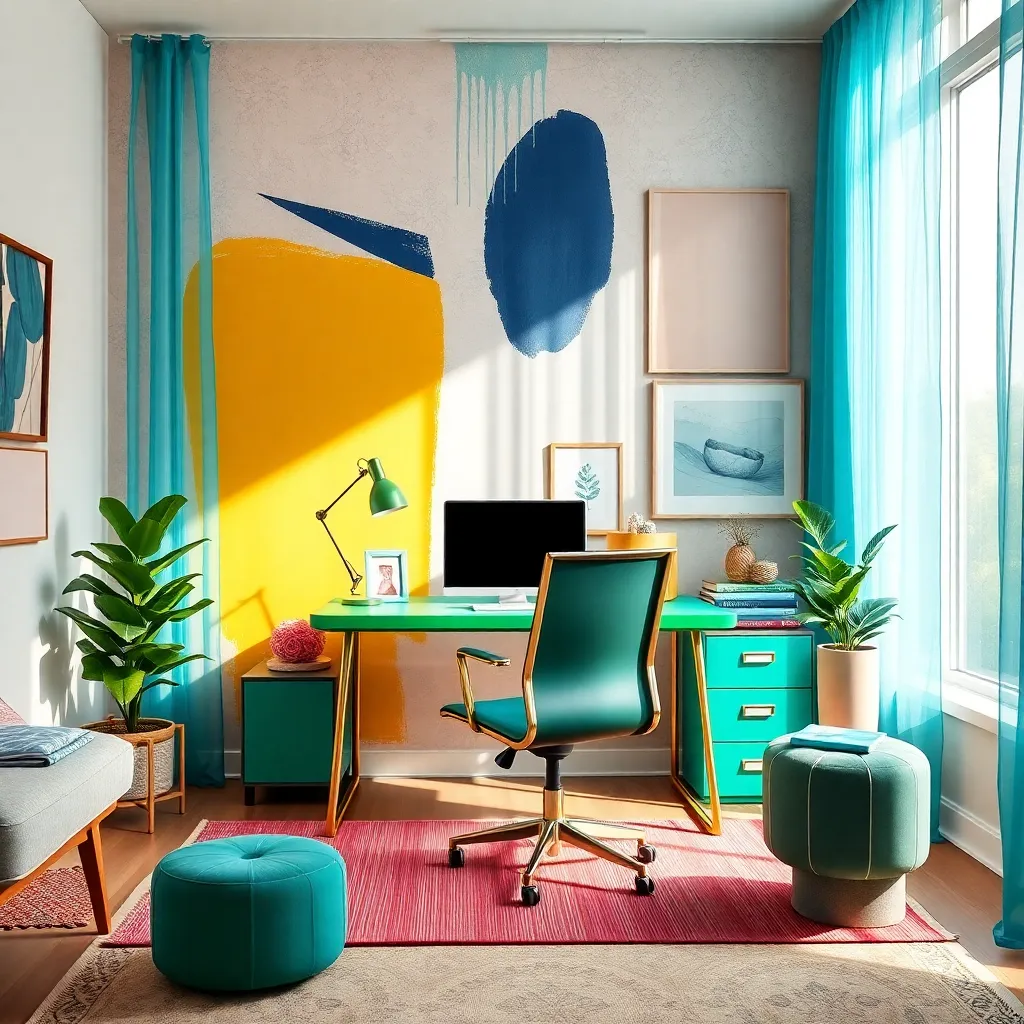
Embracing bold color schemes can transform your home office into a vibrant and stimulating environment. Start by selecting a dominant color, like a rich teal or deep mustard, and build your palette around it with complementary hues.
To create a balanced look, incorporate bold colors through accent walls, furniture pieces, or decorative accessories. For instance, a bright red desk can serve as a focal point, while patterned cushions in coordinating shades tie the room together.
For beginners, sticking to the 60-30-10 rule can help achieve a harmonious color scheme. This means using 60% of a primary color, 30% of a secondary color, and 10% for an accent, ensuring a cohesive and dynamic space.
Advanced decorators might explore using color blocking techniques on walls or cabinets to add depth and interest. Pairing a navy wall with a pop of coral drawer fronts can create a sophisticated yet playful ambiance.
Consider the psychological effects of color when designing your office space. Bold hues like blue and green can promote focus and calm, while brighter tones like orange and yellow may enhance creativity and energy.
Infusing Personal Artistic Touches
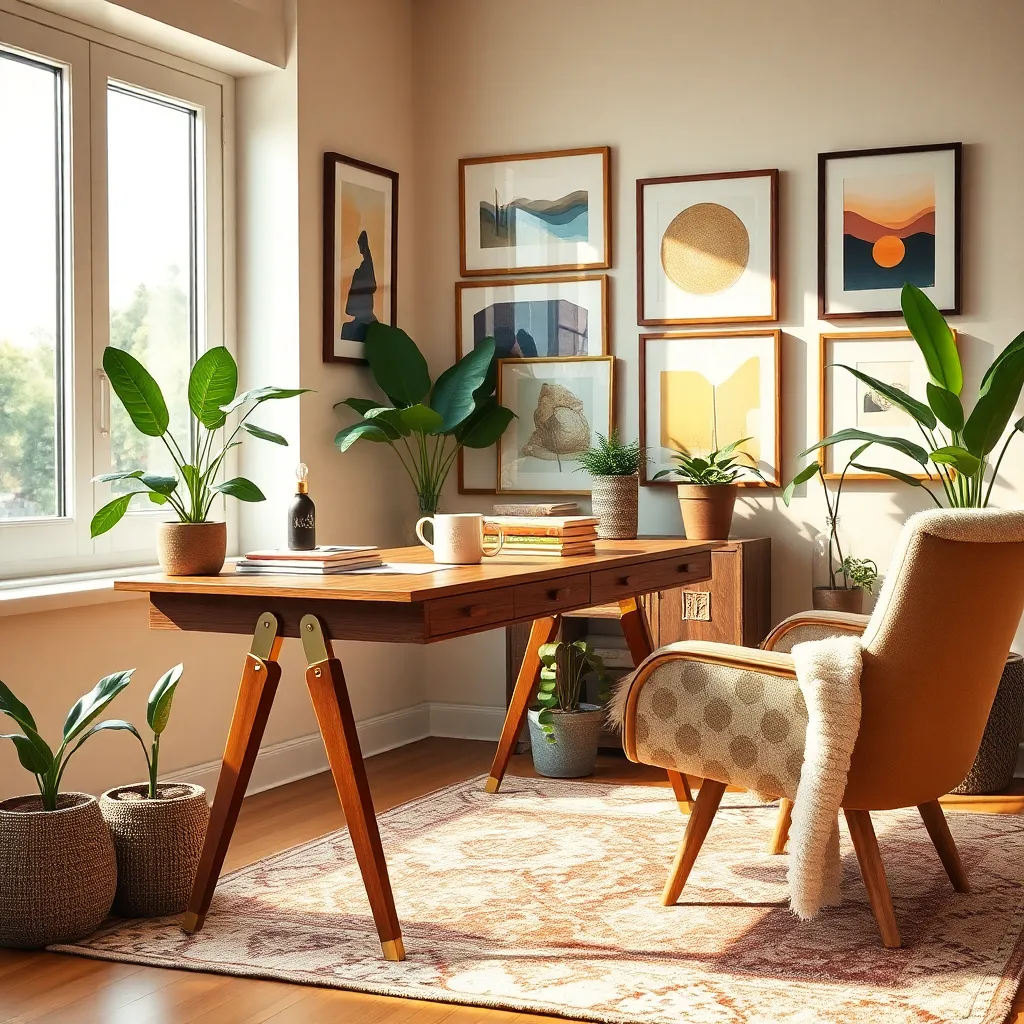
Unleashing your creativity in your home office can start with incorporating personal artwork or handmade crafts. This could mean hanging a series of your favorite art prints or creating a gallery wall with a mix of personal photographs and artworks, all framed in complementary colors to tie the space together.
Another way to infuse a personal artistic touch is by selecting a statement piece of furniture that reflects your style—consider a vintage desk or a sleek, modern chair. Position this piece where it can be both functional and visually striking, such as placing the desk near a window to take advantage of natural light.
For those who enjoy a hands-on approach, try creating an accent wall using removable wallpaper or stencils, which allows you to change designs as your tastes evolve. Opt for patterns or colors that resonate with your personal aesthetic, ensuring they harmonize with the rest of your office decor.
Adding unique textiles can also bring a personal flair to your workspace. Consider layering a vibrant rug or textured throw over your office chair for a cozy yet stylish ambiance, selecting colors that either complement or contrast your existing color scheme for added depth.
Implementing Greenery for Freshness
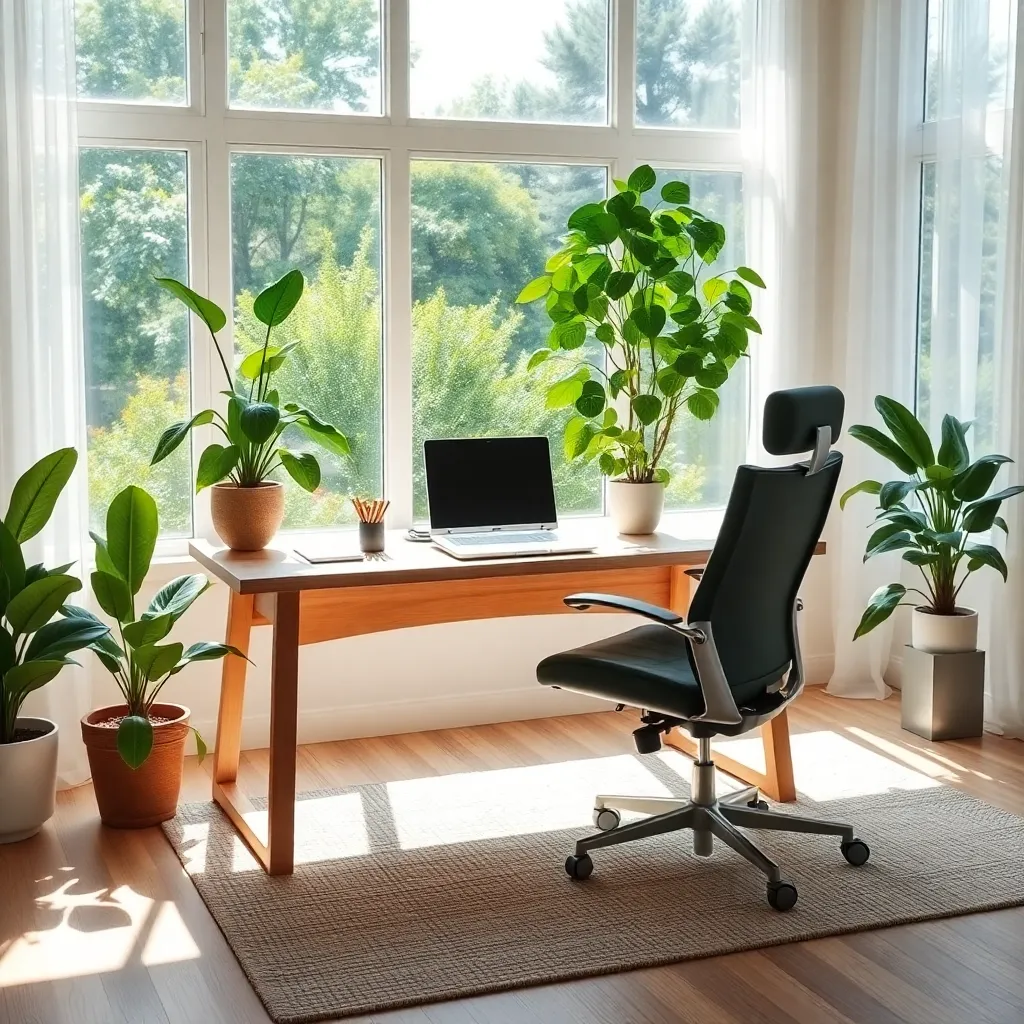
Incorporating greenery into your home office can create a sense of freshness and vitality that enhances productivity. Start by selecting plants that thrive indoors, such as snake plants, pothos, or peace lilies, which are both low-maintenance and visually appealing.
Consider placing a tall plant, like a fiddle leaf fig, in an empty corner to add height and interest to the space. Smaller plants, such as succulents or herbs, can be placed on shelves or your desk to create a cohesive look without overwhelming the area.
Using planters that complement your existing color scheme can further integrate greenery into your design. Choose neutral ceramic pots for a minimalist look, or opt for bold, colorful planters to make your plants the focal point of the room.
For those looking to add a more advanced touch, consider creating a vertical garden or installing a plant wall. This not only maximizes space but also introduces a lush, green backdrop that can act as a living piece of art in your office.
Designing Flexible Work Zones
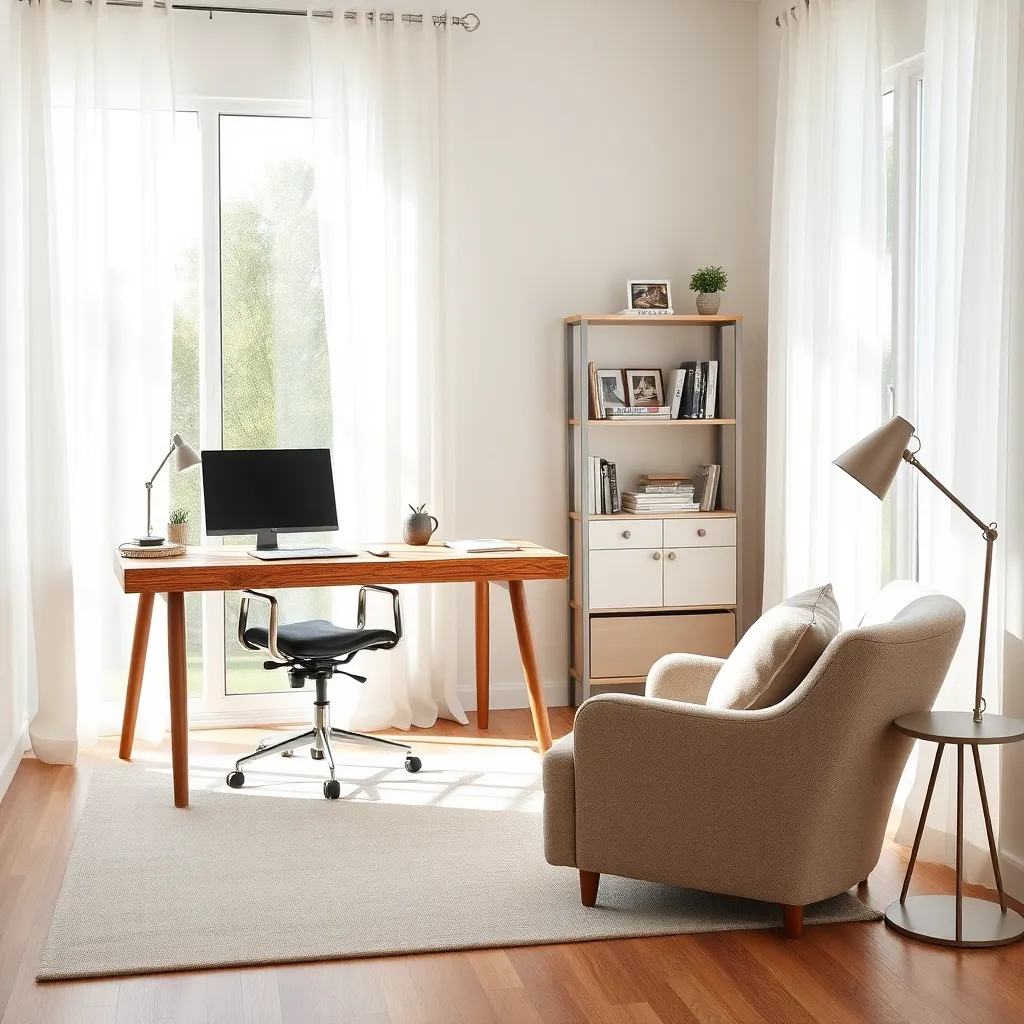
Designing flexible work zones in your home office can significantly enhance productivity and comfort. Start by selecting furniture pieces like adjustable desks and chairs that can adapt to different tasks and postures, ensuring both comfort and efficiency.
Incorporating multi-functional furniture can greatly optimize limited space. Consider using foldable desks or wall-mounted tables that can be tucked away when not in use, providing a clean and uncluttered environment.
Color schemes also play a vital role in creating a flexible work zone. Opt for neutral tones like soft grays or muted blues to foster concentration, while introducing pops of color through accessories to stimulate creativity.
Lighting is another crucial element in flexible work zones. Use adjustable lighting fixtures that can switch between warm and cool tones, catering to different times of the day and types of work, ensuring your workspace is always well-lit and inviting.
Embracing Minimalistic Design Principles
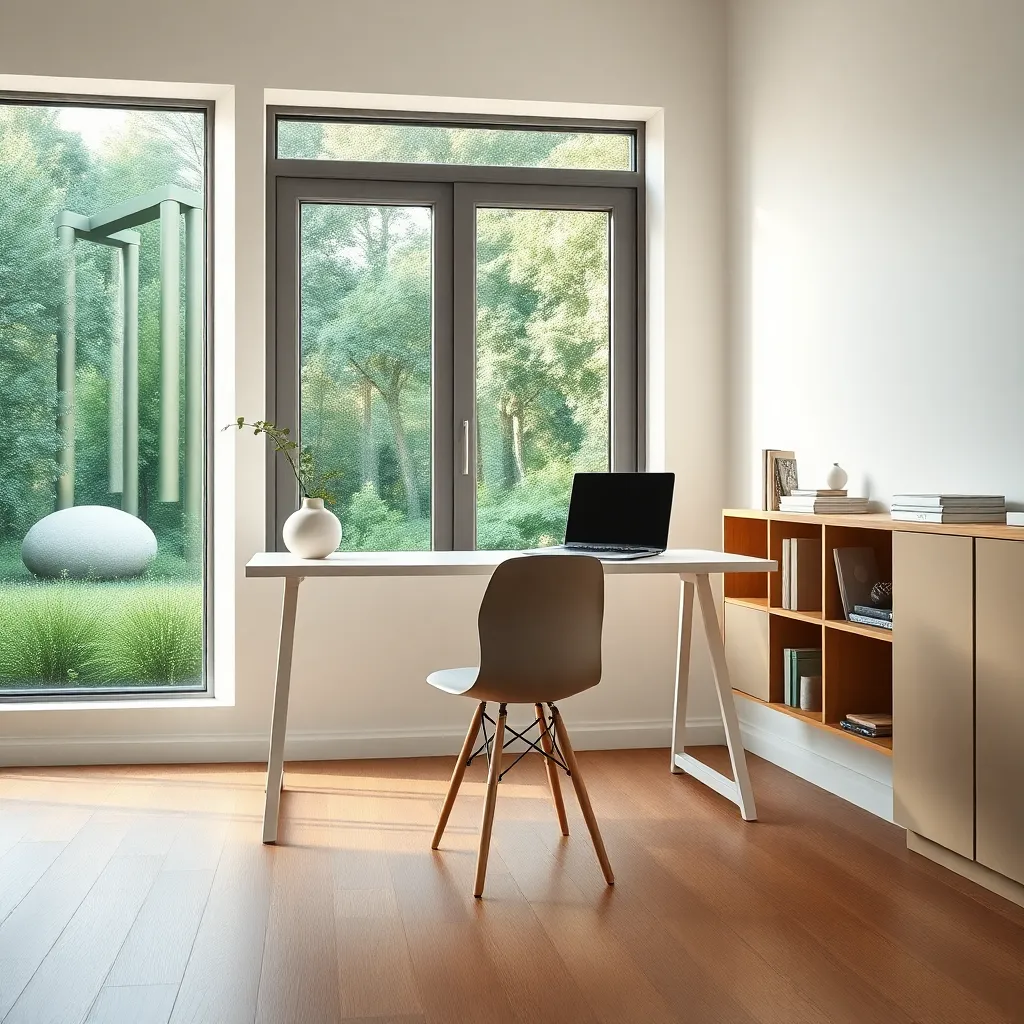
When embracing minimalistic design principles for your home office, start by removing all non-essential items to create an open and clutter-free space. This approach not only enhances focus but also promotes a sense of tranquility, which is essential for productivity.
Focus on selecting furniture that is both functional and stylish, such as a sleek, streamlined desk with built-in storage to maintain a tidy surface. Opt for pieces made from natural materials like wood or metal, which add a touch of warmth and sophistication without overwhelming the space.
Incorporate a neutral color palette, using shades like white, beige, or soft gray to create a serene backdrop. To add depth and interest, integrate subtle textures through textiles, such as a cozy wool rug or linen curtains.
For those ready to delve deeper into minimalism, consider the concept of negative space, which involves leaving areas intentionally unadorned to enhance the overall aesthetic. This technique not only offers visual relief but also highlights the beauty of each carefully chosen piece.
Incorporating Tech-Friendly Elements
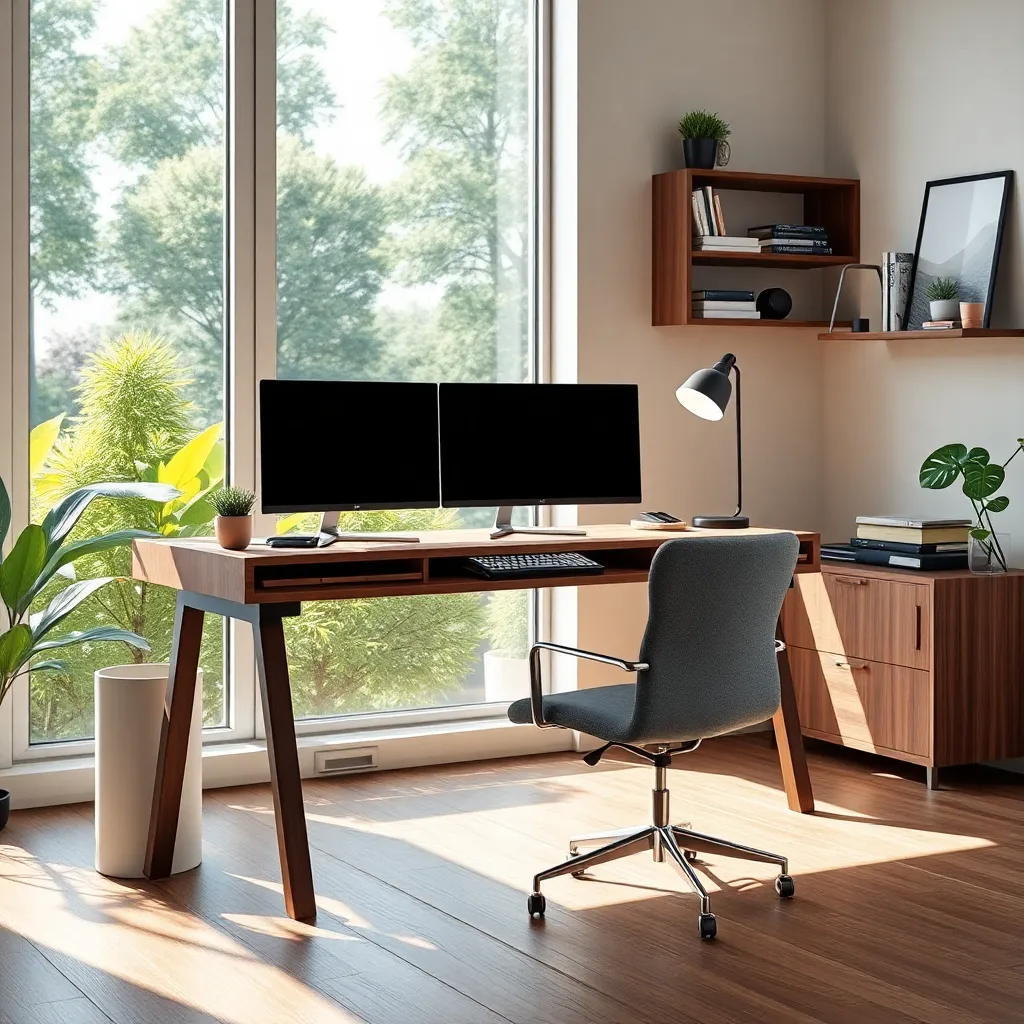
Integrating technology into your home office can greatly enhance both functionality and aesthetic appeal. Start by selecting a desk with built-in cable management systems to keep wires organized and out of sight, maintaining a clean and clutter-free workspace.
Consider incorporating smart lighting solutions that allow you to adjust the ambiance with a simple touch or voice command. Opt for lamps and overhead lighting that offer adjustable brightness and color temperature settings to suit your work needs throughout the day.
For an advanced touch, add a wireless charging station seamlessly into your desk or side table to maintain a sleek, modern look. This not only provides convenience but also reduces the need for multiple cables, further enhancing your minimalist approach.
Moreover, choose tech-friendly furniture that complements your space’s design while offering practical benefits. Items like ergonomic chairs with USB ports or desks with integrated power strips ensure comfort and efficiency without sacrificing style.
Crafting a Calming Ambiance
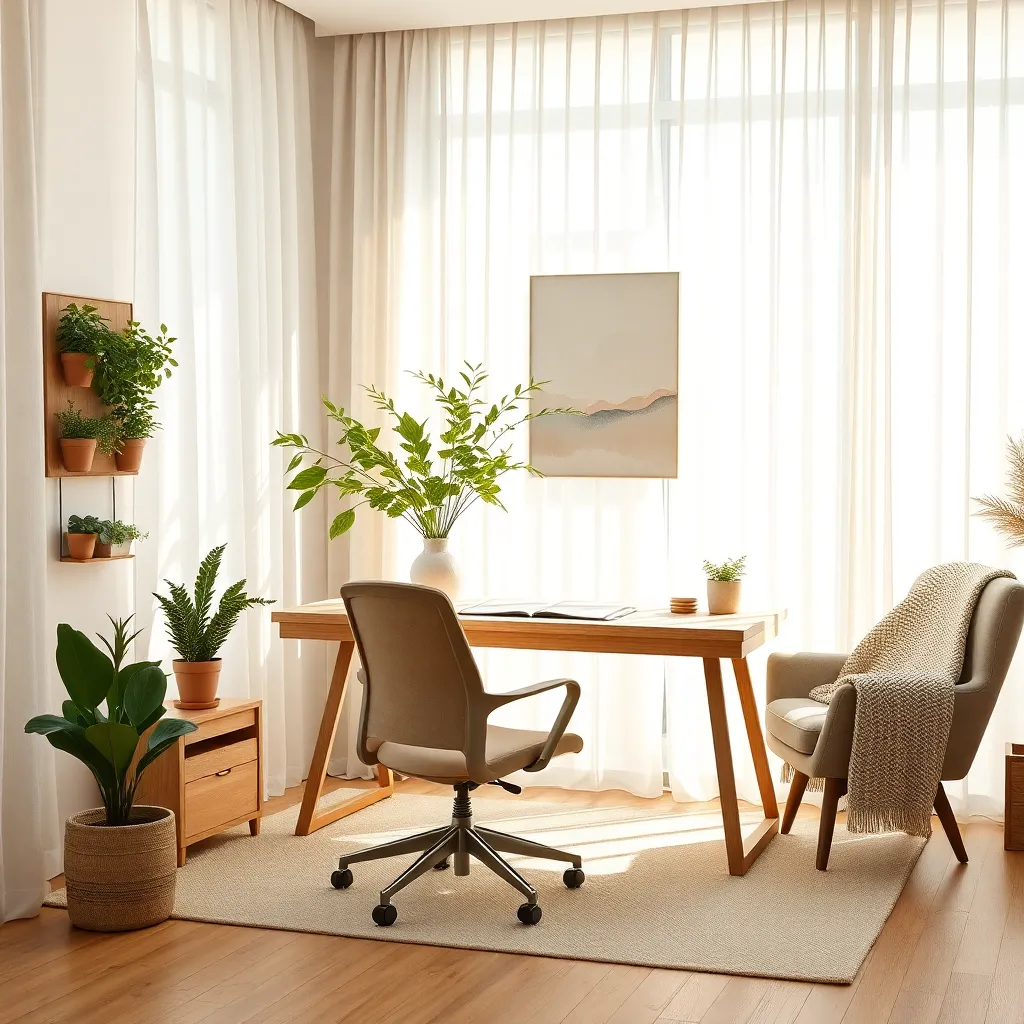
Creating a calming ambiance in your home office starts with selecting a soft and soothing color palette. Opt for hues like muted blues, gentle greens, or warm neutrals, which can help reduce stress and foster concentration.
Consider investing in comfortable, ergonomic furniture that supports both body and mind. A well-cushioned chair with lumbar support and a desk at the correct height can make long hours more bearable.
Integrating natural elements can significantly enhance the tranquility of your workspace. Include details like a small indoor plant or a water feature to bring a sense of serenity and balance to your environment.
For those looking to add a personal touch, incorporate textural elements such as a cozy throw or a soft area rug. These additions not only provide warmth but also contribute to the overall sensory comfort of the space.
Lighting plays a crucial role in crafting a calming atmosphere. Utilize adjustable lamps that allow you to control brightness levels, ensuring adequate light for tasks while maintaining a gentle glow to ease the eyes during breaks.
Adding Accents with Textures
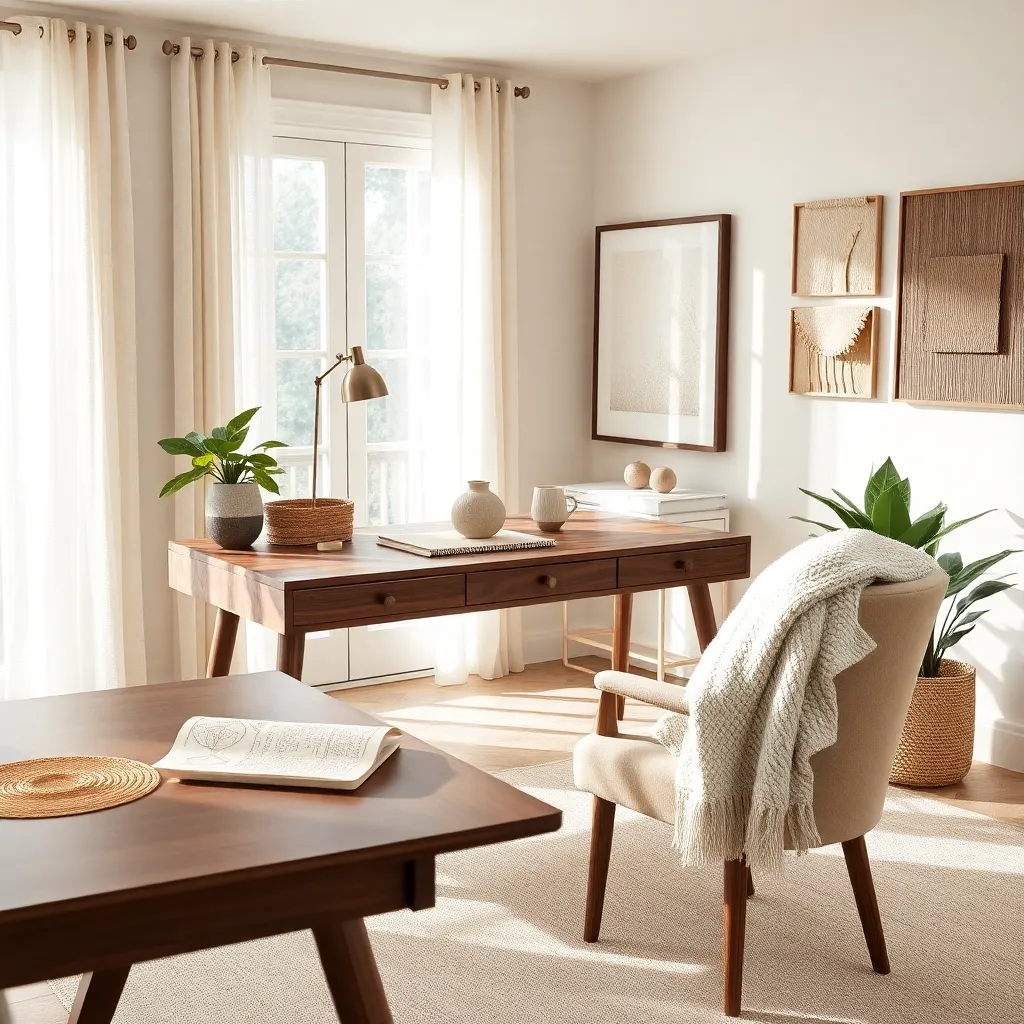
Incorporating various textures is a powerful way to add depth and interest to your home office. Begin by choosing a textured area rug to anchor the space, which can instantly make the room feel cozier and more inviting.
Consider layering different materials to create a visually stimulating environment. For example, pair a smooth leather chair with a nubby wool throw for a sophisticated contrast that is both tactile and visually appealing.
Don’t overlook the walls when adding texture to your home office. Incorporating a textured wallpaper or a simple shiplap accent wall can bring dimension and warmth to the room without overwhelming the space.
Experiment with a mix of materials in your decorative accents, such as using ceramic vases alongside glass or metal objects. This combination not only adds texture but also creates a balanced and harmonious look that can make your workspace more dynamic.
Creating Inspiring Wall Art
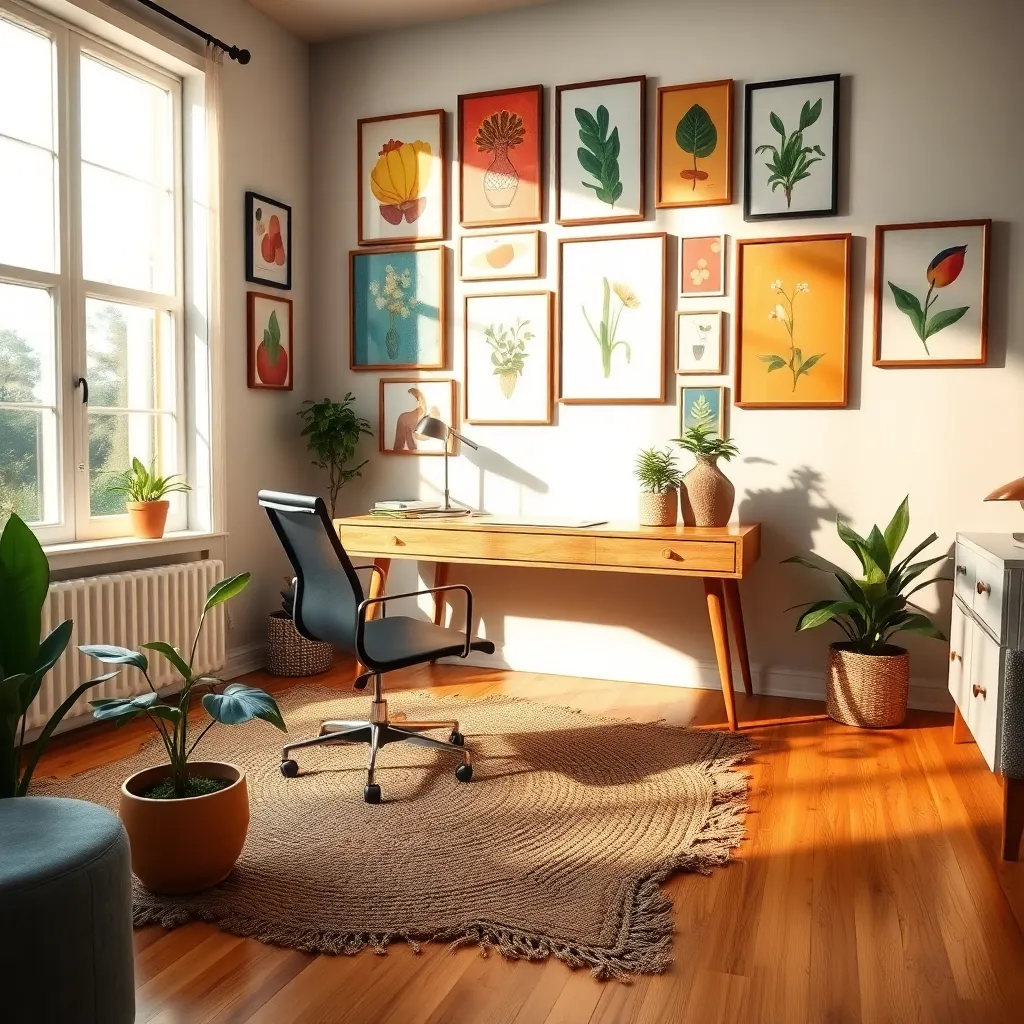
Incorporating wall art in your home office can instantly elevate the space and boost creativity. Begin by selecting pieces that resonate with you personally, as this will ensure your office feels both inspiring and uniquely yours. Color coordination is key when choosing wall art, so look for art pieces that complement your existing office palette. This cohesiveness can be achieved by pulling colors from your furniture, rugs, or even other decorative items.
For a balanced look, consider the scale and proportion of the artwork relative to your wall space. Large statement pieces work well on expansive walls, while a series of smaller frames can create a dynamic gallery effect. To achieve this, lay out your selected art pieces on the floor first to experiment with different configurations before committing to the wall.
Mixing different styles and media can add depth and interest to your office environment. Combine photography with paintings or include textured art such as fabric or wood pieces for a more tactile experience. Ensure the frames or mounting materials are consistent to maintain a cohesive look, even when the art styles vary.
Lighting plays a crucial role in highlighting your wall art, so don’t overlook this aspect. Use adjustable spotlights or picture lights to draw attention to your favorite pieces and create an inviting ambiance. Natural light can also enhance the visuals, so position your art where it can benefit from sunlight without risking damage.
Conclusion: Growing Success with These Plants
As we explored in ’13 Refreshing Creative Home Office Designs,’ each innovative workspace design can significantly enhance your relationship with productivity, creativity, and even your partner. We’ve covered how integrating personal touches fosters emotional connections, while shared workspaces can nurture collaboration. Thoughtful color schemes can elevate mood, and ergonomic setups show love through care for well-being. The importance of setting boundaries, personalizing spaces, and creating zones for different activities all contribute to a harmonious home environment.
Now, take a moment to evaluate your current workspace and choose one design element to implement today—perhaps adding a personal memento or reorganizing for better flow. This small step can transform not just your office, but the way you connect with those around you.
Don’t forget to save or bookmark this article! It’s a valuable resource for continuously improving your home and relationship dynamics. As you adapt these ideas, remember that a nurturing environment is an ongoing journey. By prioritizing these elements, you’re paving the way for lasting relationship success and personal fulfillment. Here’s to creating spaces that inspire both work and love!
